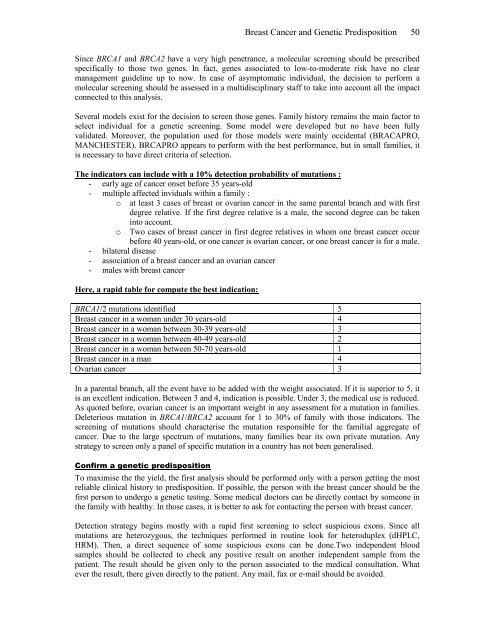Breast Cancer - Arab Medical Association Against Cancer
Breast Cancer - Arab Medical Association Against Cancer
Breast Cancer - Arab Medical Association Against Cancer
- No tags were found...
You also want an ePaper? Increase the reach of your titles
YUMPU automatically turns print PDFs into web optimized ePapers that Google loves.
<strong>Breast</strong> <strong>Cancer</strong> and Genetic Predisposition 50Since BRCA1 and BRCA2 have a very high penetrance, a molecular screening should be prescribedspecifically to those two genes. In fact, genes associated to low-to-moderate risk have no clearmanagement guideline up to now. In case of asymptomatic individual, the decision to perform amolecular screening should be assessed in a multidisciplinary staff to take into account all the impactconnected to this analysis.Several models exist for the decision to screen those genes. Family history remains the main factor toselect individual for a genetic screening. Some model were developed but no have been fullyvalidated. Moreover, the population used for those models were mainly occidental (BRACAPRO,MANCHESTER). BRCAPRO appears to perform with the best performance, but in small families, itis necessary to have direct criteria of selection.The indicators can include with a 10% detection probability of mutations :- early age of cancer onset before 35 years-old- multiple affected inviduals within a family :o at least 3 cases of breast or ovarian cancer in the same parental branch and with firstdegree relative. If the first degree relative is a male, the second degree can be takenointo account.Two cases of breast cancer in first degree relatives in whom one breast cancer occurbefore 40 years-old, or one cancer is ovarian cancer, or one breast cancer is for a male.- bilateral disease- association of a breast cancer and an ovarian cancer- males with breast cancerHere, a rapid table for compute the best indication:BRCA1/2 mutations identified 5<strong>Breast</strong> cancer in a woman under 30 years-old 4<strong>Breast</strong> cancer in a woman between 30-39 years-old 3<strong>Breast</strong> cancer in a woman between 40-49 years-old 2<strong>Breast</strong> cancer in a woman between 50-70 years-old 1<strong>Breast</strong> cancer in a man 4Ovarian cancer 3In a parental branch, all the event have to be added with the weight associated. If it is superior to 5, itis an excellent indication. Between 3 and 4, indication is possible. Under 3, the medical use is reduced.As quoted before, ovarian cancer is an important weight in any assessment for a mutation in families.Deleterious mutation in BRCA1/BRCA2 account for 1 to 30% of family with those indicators. Thescreening of mutations should characterise the mutation responsible for the familial aggregate ofcancer. Due to the large spectrum of mutations, many families bear its own private mutation. Anystrategy to screen only a panel of specific mutation in a country has not been generalised.Confirm a genetic predispositionTo maximise the the yield, the first analysis should be performed only with a person getting the mostreliable clinical history to predisposition. If possible, the person with the breast cancer should be thefirst person to undergo a genetic testing. Some medical doctors can be directly contact by someone inthe family with healthy. In those cases, it is better to ask for contacting the person with breast cancer.Detection strategy begins mostly with a rapid first screening to select suspicious exons. Since allmutations are heterozygous, the techniques performed in routine look for heteroduplex (dHPLC,HRM). Then, a direct sequence of some suspicious exons can be done.Two independent bloodsamples should be collected to check any positive result on another independent sample from thepatient. The result should be given only to the person associated to the medical consultation. Whatever the result, there given directly to the patient. Any mail, fax or e-mail should be avoided.









